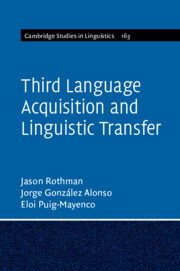Book contents
- Third Language Acquisition and Linguistic Transfer
- Cambridge Studies in Linguistics
- Third Language Acquisition and Linguistic Transfer
- Copyright page
- Dedication
- Contents
- Figures
- Tables
- Acknowledgments
- 1 Setting the Context
- 2 Theoretical Approaches to Sequential Multilingualism
- 3 Multilingual Lexis (Acquisition and Processing) and Phonology
- 4 Transfer in Multilingual Morphosyntax
- 5 A Review of Published Work
- 6 Moving On and Going Forward in L3/Ln Acquisition
- Appendix A
- Appendix B
- Appendix C
- References
- Index
3 - Multilingual Lexis (Acquisition and Processing) and Phonology
Published online by Cambridge University Press: 07 October 2019
- Third Language Acquisition and Linguistic Transfer
- Cambridge Studies in Linguistics
- Third Language Acquisition and Linguistic Transfer
- Copyright page
- Dedication
- Contents
- Figures
- Tables
- Acknowledgments
- 1 Setting the Context
- 2 Theoretical Approaches to Sequential Multilingualism
- 3 Multilingual Lexis (Acquisition and Processing) and Phonology
- 4 Transfer in Multilingual Morphosyntax
- 5 A Review of Published Work
- 6 Moving On and Going Forward in L3/Ln Acquisition
- Appendix A
- Appendix B
- Appendix C
- References
- Index
Summary
In the same spirit as the previous chapter, the present one endeavors to further contextualize the larger puzzle in which L3 morphosyntactic studies are located. In fact, it is important to understand the historical provenance of the theories and related empirical work within L3/Ln morphosyntax on which the remainder of the book will focus. In equal measure, it is important to keep abreast of the trends in the related fields of multilingual acquisition and processing, not only to be a well-rounded L3/Ln scholar but also to understand one’s own subarea better and to ensure the continuity of ideas via potential, when appropriate, cross-fertilization. Thus, before traveling down the road of L3/Ln morphosyntax and transfer studies from a formal linguistic perspective, it makes sense to recap what has been or is being done in the related fields of multilingual lexical processing and acquisition, as well as in phonology.
Keywords
- Type
- Chapter
- Information
- Third Language Acquisition and Linguistic Transfer , pp. 75 - 115Publisher: Cambridge University PressPrint publication year: 2019

